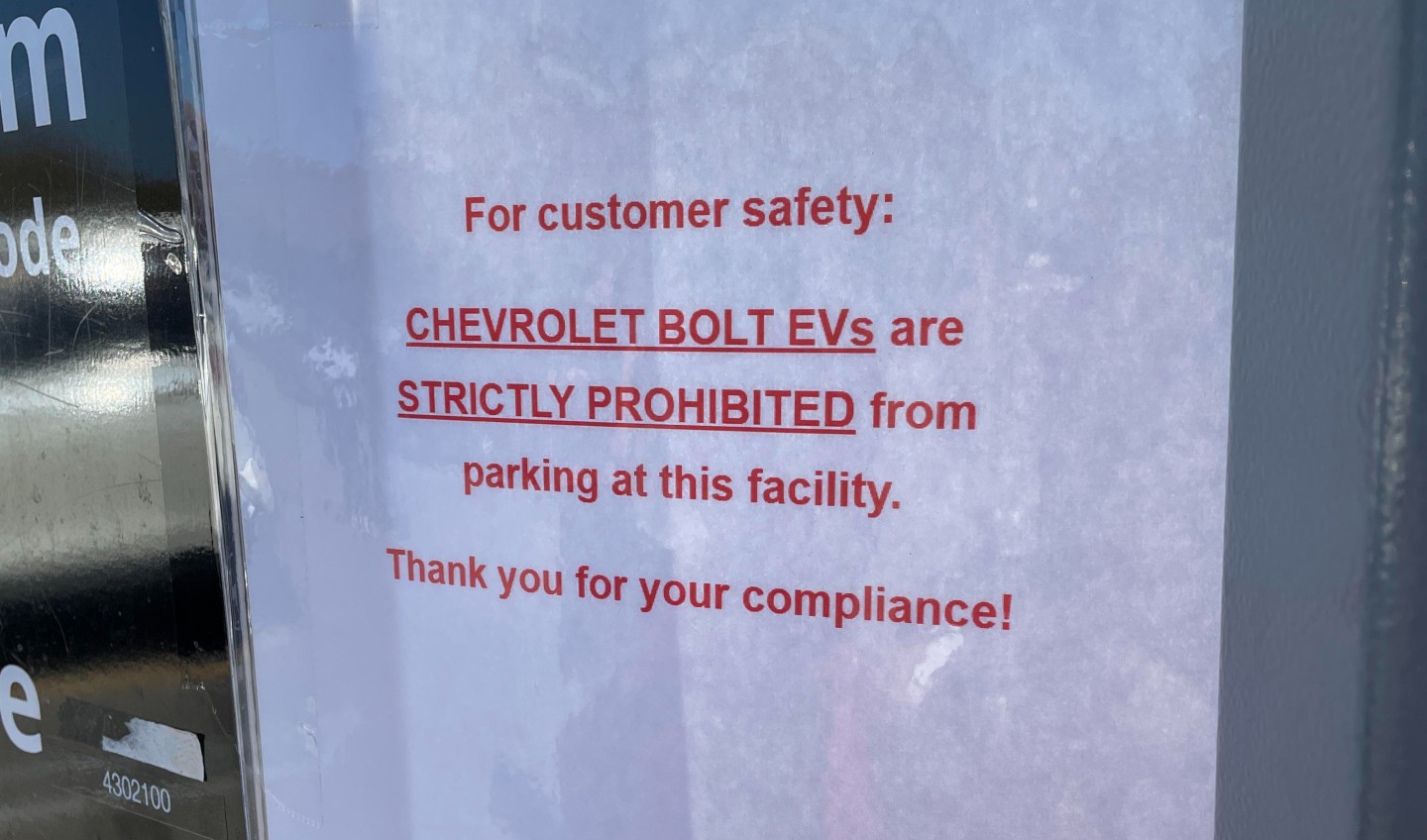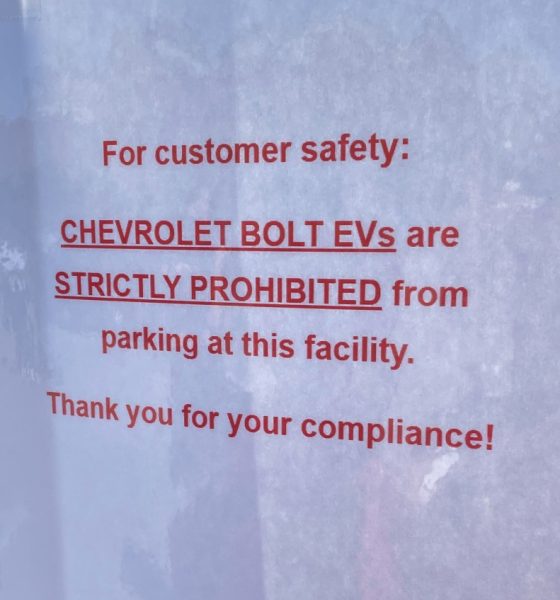

News
Chevrolet Bolt EV owners may have trouble with parking after battery recalls
Chevrolet Bolt EVs have been in the news quite frequently as of late due to their extensive recall from General Motors due to battery cell malfunctions that could cause fires. However, a parking lot is taking precautions to an extreme measure by banning Bolt EVs from their facility due to the recalls, which have been heavily covered in the past few weeks.
The Bolt EV has had recalls three times over the past year due to battery issues. The first was in November 2020, with the second and third coming within the last several months after battery malfunctions in cells provided by LG Energy Solutions could have “the simultaneous presence of two rare manufacturing defects in the same battery cell.” GM’s second recall covered 69,000 vehicles total. Still, the company then decided to extend the recall by spending an additional billion dollars on other vehicles that were not listed in the initial recalls “out of an abundance of caution.” So far, GM has spent $1.8 billion on the recall since Q2.
How the Chevy Bolt EV became GM’s 1.8 billion dollar problem
GM encouraged owners to limit their state of charge to 90% and avoid depleting their battery below 70 miles of remaining range when possible. Additionally, owners were encouraged to park their vehicles outside after charging and not charge their cars overnight as a precaution.
Because of the mass amount of media attention the Bolt EV recall has received, some entities are now banning the vehicle’s presence on its premises. A parking lot in San Francisco is one example.
A sign was seen at the lot by Reddit user u/scarls13, who took a picture of the warning that read:
“For customer safety:
CHEVROLET BOLT EVs are STRICTLY PROHIBITED from parking at this facility.
Thank you for your compliance!”
The owner of the lot likely was taking a necessary and understandable precaution, but this sort of message could be detrimental to the development of electric vehicles. Just as media coverage fixates on instances of Tesla Autopilot irresponsibilities, EV fires, and commonly spread misinformation regarding EVs in general, the Bolt EV story has become a mainstay of fear for those who are still skeptical of the EV movement. It is important to remember that GM, Chevrolet, and LG Energy Solutions have taken drastic steps to fix the issue, even recalling non-effected vehicles to have battery packs replaced to prevent further events of combustion.
Statistically, EV fires are not a common occurrence. FEMA stated that 171,500 vehicle fires occurred annually on average between 2014 and 2016. Only 10 of these fires were Bolts, and ICE vehicles made up a vast majority of the vehicles that caught fire. The 269 million vehicles on the road in the U.S. in 2016 and one in 1,569 fossil fuel-powered vehicles caught fire during that time. Furthermore, there were 1.2 million EVs in China in 2018, but one in 30,000 vehicles caught fire. This effectively means that an ICE vehicle was twenty-times more likely to catch fire than an EV, according to Forbes.
Of course, it is understandable to be preventative and safe, but the Bolt EV fires are still a statistically rare occurrence. GM admitting its wrongs and pushing toward full replacements of battery cells to prevent future instances of fires should begin to take control of signs like the ones above, but lot owners are within their rights to refuse service to anyone for any reason.
Don’t hesitate to contact us with tips! Email us at tips@teslarati.com, or you can email me directly at joey@teslarati.com.

News
Elon Musk’s Grokipedia surges to 5.6M articles, almost 79% of English Wikipedia
The explosive growth marks a major milestone for the AI-powered online encyclopedia, which was launched by Elon Musk’s xAI just months ago.

Elon Musk’s Grokipedia has grown to an impressive 5,615,201 articles as of today, closing in on 79% of the English Wikipedia’s current total of 7,119,376 articles.
The explosive growth marks a major milestone for the AI-powered online encyclopedia, which was launched by Elon Musk’s xAI just months ago. Needless to say, it would only be a matter of time before Grokipedia exceeds English Wikipedia in sheer volume.
Grokipedia’s rapid growth
xAI’s vision for Grokipedia emphasizes neutrality, while Grok’s reasoning capabilities allow for fast drafting and fact-checking. When Elon Musk announced the initiative in late September 2025, he noted that Grokipedia would be an improvement to Wikipedia because it would be designed to avoid bias.
At the time, Musk noted that Grokipedia “is a necessary step towards the xAI goal of understanding the Universe.”
Grokipedia was launched in late October, and while xAI was careful to list it only as Version 0.1 at the time, the online encyclopedia immediately earned praise. Wikipedia co-founder Larry Sanger highlighted the project’s innovative approach, noting how it leverages AI to fill knowledge gaps and enable rapid updates. Netizens also observed how Grokipedia tends to present articles in a more objective manner compared to Wikipedia, which is edited by humans.
Elon Musk’s ambitious plans
With 5,615,201 total articles, Grokipedia has now grown to almost 79% of English Wikipedia’s article base. This is incredibly quick, though Grokipedia remains text-only for now. xAI, for its part, has now updated the online encyclopedia’s iteration to v0.2.
Elon Musk has shared bold ideas for Grokipedia, including sending a record of the entire knowledge base to space as part of xAI’s mission to preserve and expand human understanding. At some point, Musk stated that Grokipedia will be renamed to Encyclopedia Galactica, and it will be sent to the cosmos.
“When Grokipedia is good enough (long way to go), we will change the name to Encyclopedia Galactica. It will be an open source distillation of all knowledge, including audio, images and video. Join xAI to help build the sci-fi version of the Library of Alexandria!” Musk wrote, adding in a later post that “Copies will be etched in stone and sent to the Moon, Mars and beyond. This time, it will not be lost.”
News
Tesla Model 3 becomes Netherlands’ best-selling used EV in 2025
More than one in ten second-hand electric cars sold in the country last year was a Tesla Model 3.

The Tesla Model 3 became the most popular used electric car in the Netherlands in 2025, cementing its dominance well beyond the country’s new-car market.
After years at the top of Dutch EV sales charts, the Model 3 now leads the country’s second-hand EV market by a wide margin, as record used-car purchases pushed electric vehicles further into the mainstream.
Model 3 takes a commanding lead
The Netherlands recorded more than 2.1 million used car sales last year, the highest level on record. Of those, roughly 4.8%, or about 102,000 vehicles, were electric. Within that growing segment, the Tesla Model 3 stood far ahead of its competitors.
In 2025 alone, 11,338 used Model 3s changed hands, giving the car an 11.1% share of the country’s entire used EV market. That means more than one in ten second-hand electric cars sold in the country last year was a Tesla Model 3, Auto Week Netherlands reported. The scale of its lead is striking: the gap between the Model 3 and the second-place finisher, the Volkswagen ID3, is more than 6,700 vehicles.
Rivals trail as residual values shape rankings
The Volkswagen ID.3 ranked a distant second, with 4,595 used units sold and a 4.5% market share. Close behind was the Audi e-tron, which placed third with 4,236 registrations. As noted by Auto Week Netherlands, relatively low residual values likely boosted the e-tron’s appeal in the used market, despite its higher original price.
Other strong performers included the Kia Niro, the Tesla Model Y, and the Hyundai Kona, highlighting continued demand for compact and midsize electric vehicles with proven range and reliability. No other model, however, came close to matching the Model 3’s scale or market presence.
News
Tesla Model Y Standard Long Range RWD launches in Europe
The update was announced by Tesla Europe & Middle East in a post on its official social media account on X.

Tesla has expanded the Model Y lineup in Europe with the introduction of the Standard Long Range RWD variant, which offers an impressive 657 km of WLTP range.
The update was announced by Tesla Europe & Middle East in a post on its official social media account on X.
Model Y Standard Long Range RWD Details
Tesla Europe & Middle East highlighted some of the Model Y Standard Long Range RWD’s most notable specs, from its 657 km of WLTP range to its 2,118 liters of cargo volume. More importantly, Tesla also noted that the newly released variant only consumes 12.7 kWh per 100 km, making it the most efficient Model Y to date.
The Model Y Standard provides a lower entry point for consumers who wish to enter the Tesla ecosystem at the lowest possible price. While the Model 3 Standard is still more affordable, some consumers might prefer the Model Y Standard due to its larger size and crossover form factor. The fact that the Model Y Standard is equipped with Tesla’s AI4 computer also makes it ready for FSD’s eventual rollout to the region.
Top Gear’s Model Y Standard review
Top Gear‘s recent review of the Tesla Model Y Standard highlighted some of the vehicle’s most notable features, such as its impressive real-world range, stellar infotainment system, and spacious interior. As per the publication, the Model Y Standard still retains a lot of what makes Tesla’s vehicles well-rounded, even if it’s been equipped with a simplified interior.
Top Gear compared the Model Y Standard to its rivals in the same segment. “The introduction of the Standard trim brings the Model Y in line with the entry price of most of its closest competition. In fact, it’s actually cheaper than a Peugeot e-3008 and costs £5k less than an entry-level Audi Q4 e-tron. It also makes the Ford Mustang Mach-E look a little short with its higher entry price and worse range,” the publication wrote.








